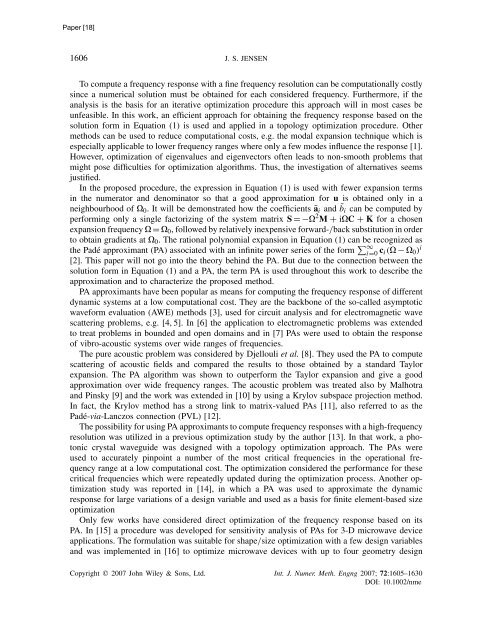WAVES AND VIBRATIONS IN INHOMOGENEOUS STRUCTURES ...
WAVES AND VIBRATIONS IN INHOMOGENEOUS STRUCTURES ...
WAVES AND VIBRATIONS IN INHOMOGENEOUS STRUCTURES ...
You also want an ePaper? Increase the reach of your titles
YUMPU automatically turns print PDFs into web optimized ePapers that Google loves.
1606 J. S. JENSEN<br />
To compute a frequency response with a fine frequency resolution can be computationally costly<br />
since a numerical solution must be obtained for each considered frequency. Furthermore, if the<br />
analysis is the basis for an iterative optimization procedure this approach will in most cases be<br />
unfeasible. In this work, an efficient approach for obtaining the frequency response based on the<br />
solution form in Equation (1) is used and applied in a topology optimization procedure. Other<br />
methods can be used to reduce computational costs, e.g. the modal expansion technique which is<br />
especially applicable to lower frequency ranges where only a few modes influence the response [1].<br />
However, optimization of eigenvalues and eigenvectors often leads to non-smooth problems that<br />
might pose difficulties for optimization algorithms. Thus, the investigation of alternatives seems<br />
justified.<br />
In the proposed procedure, the expression in Equation (1) is used with fewer expansion terms<br />
in the numerator and denominator so that a good approximation for u is obtained only in a<br />
neighbourhood of 0. It will be demonstrated how the coefficients ãi and ˜bi can be computed by<br />
performing only a single factorizing of the system matrix S =− 2 M + iC + K for a chosen<br />
expansion frequency = 0, followed by relatively inexpensive forward-/back substitution in order<br />
to obtain gradients at 0. The rational polynomial expansion in Equation (1) can be recognized as<br />
the Padé approximant (PA) associated with an infinite power series of the form ∞ i=0 ci( − 0) i<br />
[2]. This paper will not go into the theory behind the PA. But due to the connection between the<br />
solution form in Equation (1) and a PA, the term PA is used throughout this work to describe the<br />
approximation and to characterize the proposed method.<br />
PA approximants have been popular as means for computing the frequency response of different<br />
dynamic systems at a low computational cost. They are the backbone of the so-called asymptotic<br />
waveform evaluation (AWE) methods [3], used for circuit analysis and for electromagnetic wave<br />
scattering problems, e.g. [4, 5]. In[6] the application to electromagnetic problems was extended<br />
to treat problems in bounded and open domains and in [7] PAs were used to obtain the response<br />
of vibro-acoustic systems over wide ranges of frequencies.<br />
The pure acoustic problem was considered by Djellouli et al. [8]. They used the PA to compute<br />
scattering of acoustic fields and compared the results to those obtained by a standard Taylor<br />
expansion. The PA algorithm was shown to outperform the Taylor expansion and give a good<br />
approximation over wide frequency ranges. The acoustic problem was treated also by Malhotra<br />
and Pinsky [9] and the work was extended in [10] by using a Krylov subspace projection method.<br />
In fact, the Krylov method has a strong link to matrix-valued PAs [11], also referred to as the<br />
Padé-via-Lanczos connection (PVL) [12].<br />
The possibility for using PA approximants to compute frequency responses with a high-frequency<br />
resolution was utilized in a previous optimization study by the author [13]. In that work, a photonic<br />
crystal waveguide was designed with a topology optimization approach. The PAs were<br />
used to accurately pinpoint a number of the most critical frequencies in the operational frequency<br />
range at a low computational cost. The optimization considered the performance for these<br />
critical frequencies which were repeatedly updated during the optimization process. Another optimization<br />
study was reported in [14], in which a PA was used to approximate the dynamic<br />
response for large variations of a design variable and used as a basis for finite element-based size<br />
optimization<br />
Only few works have considered direct optimization of the frequency response based on its<br />
PA. In [15] a procedure was developed for sensitivity analysis of PAs for 3-D microwave device<br />
applications. The formulation was suitable for shape/size optimization with a few design variables<br />
and was implemented in [16] to optimize microwave devices with up to four geometry design<br />
Copyright q 2007 John Wiley & Sons, Ltd. Int. J. Numer. Meth. Engng 2007; 72:1605–1630<br />
DOI: 10.1002/nme

















